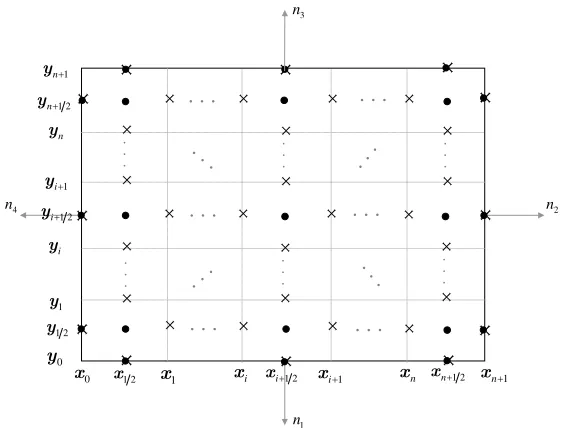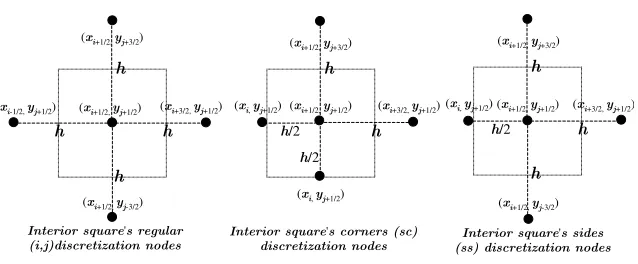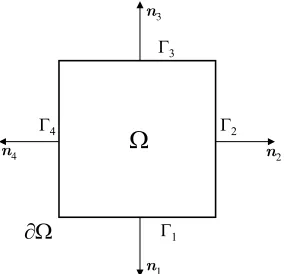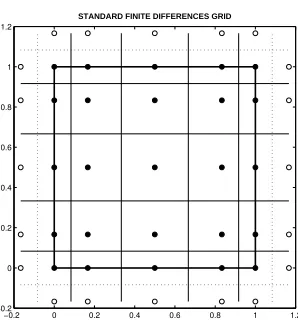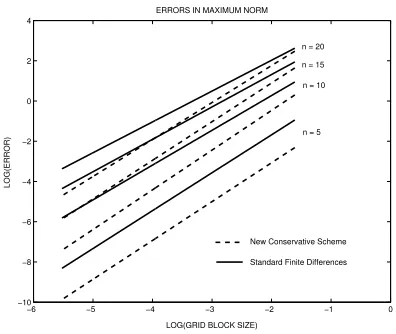A Conservative Finite Difference
Scheme for Static Diffusion Equation
Un M´
etodo Conservativo de Diferencias Finitas
para la Ecuaci´
on Est´
atica de Difusi´
on
J. Arteaga-Arispe (
)
Departamento de Matem´aticas, Universidad Central de VenezuelaLos Chaguaramos, Caracas 1020
J.M. Guevara-Jordan (
)
Departamento de Matem´aticas, Universidad Central de Venezuela Los Chaguaramos, Caracas 1020
Abstract
A new discretization scheme for partial differential equations, based on the finite differences method, and its application to the two dimen-sional static diffusion equation is presented. This scheme produces bet-ter approximations than a standard use of finite differences. It satisfies properties of continuous differential operators and discrete versions of integral identities, which guarantee its conservative character. In addi-tion, a global quadratic convergence rate is obtained naturally from the gradient second order one-sided approximation at the boundary nodes on a non-uniform staggered grid (of distributed points). This approach avoids the commonly used ghost points or extended grid concepts.
Key words and phrases: conservative discretizations; finite differ-ence; divergdiffer-ence; gradient; static diffusion equation; Robin boundary conditions; boundary layer.
Resumen
Se presenta un nuevo esquema de discretizaci´on para ecuaciones en derivadas parciales, basado en el m´etodo de diferencias finitas, y su apli-caci´on a la ecuaci´on est´atica de difusi´on en dos dimensiones. El nuevo m´etodo produce mejores aproximaciones que los esquemas tradicionales de diferencias finitas est´andar. Este satisface propiedades de operado-res diferenciales continuos y las versiones discretas de las identidades
integrales, garantizando as´ı su car´acter conservativo. Adicionalmente, una tasa cuadr´atica global de convergencia es obtenida naturalmente de la aproximaci´on unilateral de segundo orden para el gradiente en los nodos de la frontera sobre una malla no uniforme escalonada (de pun-tos distribuidos). Esta metodolog´ıa elimina el uso de nodos fantasmas y mallas extendidas.
Palabras y frases clave:discretizaciones conservativas; diferencias fi-nitas; divergencia; gradiente; ecuaci´on de difusi´on; condiciones de borde tipo Robin; capa de frontera (capa l´ımite)
1
Introduction
The Ghost points and extended grids are normally used in discretizations of partial differential equations and boundary conditions by standard finite difference methods [1, 2, 3, 4]. They have the great advantage that their for-mulation is straightforward, but some regularity at the boundary is implicitly assumed. This assumption is not well justified and it produces weak numerical schemes.
Recently, a new set of mimetic discretizations for gradient and divergence operators based on one side higher order lateral approximations at boundaries was developed in [5]. Applications of those discretizations for solving partial differential equations have been reported in [6, 7, 8]. They provided strong evidences that the second order mimetic schemes applied to partial differential equations achieve global quadratic convergence rates. In [9] a rigorous proof of this fact has been given for the one dimensional static diffusion equation. Moreover, it has been found that every mimetic scheme, based on the ap-proximation presented in [5], allows an associated conservative scheme with a simpler formulation, an easier computer implementation and approxima-tions as accurate as those produced by fully mimetic schemes. A proof of its quadratic convergence rate was presented for one dimensional static diffusion equation in [9, 10].
methods. Its analysis was originally obtained, as a partial result, in [11]. A theoretical convergence analysis, a general matrix representation and a set of numerical results of the new conservative scheme have not been reported in a multidimensional context; they represents main contributions of this work, and a natural continuation and a generalized formal extension of the one dimensional studies [9, 10].
The rest of this article is divided into several sections, covering the contin-uous model, a description of the new second order conservative scheme, proofs of its quadratic convergence rate and conservative properties, a numerical test and conclusions.
2
Continuous Model
In this section the multidimensional static diffusion equation will be presented. Since this is one of the most important and widely used equation in mathe-matical physics, the effort and time devoted in finding ways to obtain high quality numerical solution of it on different contexts are well justified. In terms of invariant operators, such as the divergence (∇·) and the gradient (∇), the static linear non-homogeneous diffusion equation is written in the form
∇ ·(K(~x)∇f(~x)) =F(~x), (1)
whereK(~x) is a symmetric tensor,f(~x) is the target property we are looking for and F(~x) represents the source term. In this context with K = I the above equation is called Poisson’s equation.
In order to have a properly posed boundary value problem, a nontriv-ial mixed (Robin type) boundary condition will be imposed. In its general formulation this condition may be written in the form
αf(~x) +β(K(~x)∇f(~x)·~n) =g(~x), (2) where the coefficientsαandβ are not zero. Discretization of boundary value problem (1)-(2) will be discussed and detailed in the next section. It should be noted that conditions provided on the static diffusion equation and its boundary conditions are sufficient for existence and uniqueness of a solution
f(~x) [12].
3
Conservative Discretization
x
x
x
x
x
x
x
x
x
. . . . . .x
x
x
x
x
x
x
x
. . .x
x
. . .x
x
. . .x
x
. . .x
x
x
x
x
. . .
x
x
. . .
x
. . .
. . .
x
x
x
x
. .
.
.
.
.
. .
.
.
.
.
2 1x xi12 xn12 0
x x1 xi xi1 xn
0 y 2 1 y 1 n x 1 y i y 2 1 i y 1 i y n y 2 1 n y 1 n y 1 n 2 n 3 n 4 n
[image:4.612.200.481.195.413.2]. . .
. . .
x
Figure 1: Staggered 2D(non-uniform point distributed) grid.
Ω = [x0, xn+1]×[y0, yn+1], where x0 =y0 = 0 and xn+1 =yn+1 = 1. This grid has (n+ 1)×(n+ 1) blocks of sizeh×h, each one of which has a central node, marked with a circle, denoted by (xi+1
2, yj+ 1
2) fori, j= 0, .., n. Notice
that each block with a side at a boundary contains an additional node and the corner blocks contain, in consequence, two of them. This non-uniform point distributed grid [13] is called a staggered uniform grid in mimetic articles. The spacing h between edges xi and/or yj is obtained from h = (xn+1−
x0)/(n+ 1) = (yn+1−y0)/(n+ 1), and it follows that xi = x0 +i h and
yj = y0+j h, where i, j = 0, .., n+ 1. The following notation will be used
f(i,j)=f(xi, yj). In this grid, the scalar functionf(~x) could be considered
as a vector having (n+ 1)2+ 4(n+ 1) components corresponding to evaluation of the functionf at the center of each cell and at the additional nodes on the boundaries, all denoted by black points in figure 1. For the sake of choosing a vector structure, nodes will be ordered from left to right and from bottom to top:
~ f =¡
f(1/2,0), .., f(n+1/2,0), f(0,1/2), .., f(n+1/2,n+1)
¢t
According to the notation of figure 1, the one-side difference approximation for the gradient at the boundary points has the form
(Gf·~n) (i1,j1)=
8
3hf(i1,j1)−
3
hf(i2,j2)+
1
3hf(i3,j3)=g(i1,j1) (4)
where, for nodes at the square’s bottom and top sides, x∈(0,1) andy = 0 or y = 1,i1 =i2 =i3 = i+ 1/2, i = 0..n, and j1 = 0, j2 = 1/2, j3 = 3/2 if
y = 0 orj1 =n+ 1, j2=n+ 1/2, j3=n−1/2 ify = 1. On the other hand, for nodes at the square’s left and right sides y ∈ (0,1) and x= 0 or x= 1
j1 =j2 =j3 =j+ 1/2, j = 0..n and i1 = 0, i2 = 1/2, i3 = 3/2 if x = 0 or
i1=n+ 1, i2=n+ 1/2, i3=n−1/2 ifx= 1.
This approximation is the same as the one obtained for a 1D gradient mimetic approximation at boundaries [6, 7, 8] and it has the advantage that it can be obtained by a straightforward application of Taylor expansions [9] or by the systematic approach developed in [5]. At inner points (cells or edges), crosses in figure 1, gradient and divergence approximations coincide with standard central difference schemes.
(Gf) (i, j)=
Ãf
(i+1
2, j)−f(i− 1 2, j)
h ,
f(i, j+1
2)−f(i, j− 1 2)
h
!
i= 1...n j = 1...n (5)
³
Dφ ψ ´
(i+1 2, j+12)
=φ(i+1, j)−φ(i, j)
h +
ψ(i, j+1)−ψ(i, j)
h
i= 0...n j= 0...n (6)
It should be noted that the discretized divergence operator (6) is defined only at inner nodes or cells centers, while the gradient is defined at all nodal points. As in [5], the construction of mimetic gradient approximationGfollows from mimetic discretized divergenceDas a consequence of imposing on both operators that they must satisfy a discrete version of the Gauss theorem,
Z
Ω
∇ ·(K∇f)dA=
Z
∂Ω
(K∇f)·~n dS. (7)
Discretized operators (4), (5) and (6) may be written in matrix form as it will be shown. It has a great advantage which is that a general partial differen-tial equation can be written as a composition of discretized operators. For example, in terms of the discretized operators, static diffusion equation may be written in the form
D(KGf(~x)) =F(~x) (8)
In matrix form, operator G matrix, denoted also by G, has dimension ˜
m×n˜ where ˜m= 2˜nand ˜n= (n+ 1)2+ 4(n+ 1) = (n+ 3)2−4. Its entries are ±8
3h,
∓3
h and
±1
3h in rows corresponding to nodes at the boundary, while at
interior nodes they are 1
hand
−1
h . On the other hand, the matrix associated to
operatorD, denoted also byD, has dimension (n+1)2×m˜ and its coefficients are the same as the one obtained from the finite difference method. F(~x) is the (n+ 1)2 vector of evaluations ofF at the interior nodes.
4
Static Diffusion Equation
The continuous model described previously by equations (1) and (2) can be approximated in matrix form, according to results presented in last section, by the linear system of equation;
(A+BG+DKG)f~=~b. (9)
In this expression, matrixAandBwith dimensions ˜n×n˜ and ˜n×m˜, respec-tively, are matrix representations of boundary conditions which have non-zero values only in rows corresponding to boundary nodes. Those mentioned val-ues are associated to αand β coefficients described in equation (2). K is a diagonal matrix whose values are positive and evaluated conservatively [7] for consistency at grid block edges. GandD are matrix representations of the operators gradient and divergence described in previous section with the ad-dition inDof 4(n+ 1) rows of zeroes, corresponding to the boundary nodes. Finally, components of~bare equal to eitherF(~x) at interior nodes org(~x) at boundary nodes.
Any general partial differential equation given in terms of the divergence and gradient operators and similar ones can be written easily in terms of the matrices described before. Notice that the equation (9) represents the most general discretization for a static diffusion equation using the conservative method proposed in this paper. Analysis of the new scheme, as it will be shown in the next section, only needs K=I in equation(9) which corresponds to Poisson’s equation discretization. Expressions of the method will be listed for this case on the staggered grid described in figure 1. Under these conditions, discretization at inner grid nodes is represented by the following expression:
(DG)f
(i+ 12,j+ 12)= f(i+ 3
2,j+ 12)+f(i−12,j+ 12)−4f(i+ 12,j+ 12)+f(i+ 12,j+ 32)+f(i+ 12,j−12) h2
article, asinterior square’s regular discretization nodes (i.n.)(figure 2).
(DG)f(i+1 2,j+
1 2)=
8
3f(i1,j1)+43f(i3,j3)−6f(i2,j2 )+f(i4,j4) +f(i5,j5)
h2 (11)
Equation (11) is only valid for inner nodes next to boundary conditions, re-ferred as interior square’s sides discretization nodes (ss)(figure 2).
(DG)f(i+1 2,j+
1 2)=
8
3f(i1,j1)+43f(i3,j3)−8f(i2,j2 )+
8
3f(i4,j4)+43f(i5,j5)
h2 (12)
This last equation is valid at inner corners nodes (interior square’s corners discretization nodes (sc)figure(2)) (1/2,1/2), (n+1/2,1/2), (n+1/2, n+1/2), (1/2, n+ 1/2) or (i = 0, j = 0),(i=n, j = 0),(i =n, j =n),(i= 0, j =n) respectively, and the relation between the generalized indexes and the grid is described by the following relation
j1=j2=j3=j+ 1/2, i1=i2=i3=i+ 1/2,
i= 0 =⇒ i1= 0, i3= 3/2,
i=n =⇒ i1=n+ 1, i3=n−1/2,
j= 0 =⇒ j4= 0, j5= 3/2,
j=n =⇒ j4=n+ 1, j5=n−1/2.
(13)
As in equation (12), generalized indexes and grid indexes for equation (11) must be related. For nodes corresponding to grid indexes j = 0 and j =n,
i= 2..n−1, generalized indexes arei1=i2=i3=i+ 1/2,i4=i+ 3/2, i5=
i−1/2, j2 =j4 =j5=j+ 1/2 and j = 0 =⇒ j1 = 0 andj3 = 3/2, while
j =n =⇒ j1 =n+ 1 and j3=n−1/2. On the left and right internal side
i= 0 andi=n,j= 1..n−1 generalized j’s indexes arej1=j2=j3=j+1/2,
j4=j+ 3/2, j5=j−1/2,i2=i4=i5=i+ 1/2 andi= 0 =⇒ i1= 0 and
i3= 3/2, whilei=n =⇒ i1=n+ 1 and i3=n−1/2.
Robin boundary conditions will be considered for ~x ∈ ∂Ω, unit square border in figure 1. In this case αand β are piecewise functions which take the followings values;
α=αi0 β=βi0 y= 0, x∈(0,1)
α=α1j β =β1j x= 1, y∈(0,1)
α=αi1 β=βi1 y= 1, x∈(0,1)
α=α0j β =β0j x= 0, y∈(0,1)
(14)
are discretized using the one-sided approximations (5). Its general expression takes the following form;
µ
α+8β 3h
¶
f(i1,j1)− 3β
hf(i2,j2)+
β
3hf(i3,j3)=g(i1,j1) (15)
where generalized indexes and their relation with the grid nodes is the same as in equation (4).
5
Convergence Analysis
In this section, the convergence analysis of the new method for a two di-mensional static diffusion equation will be presented. As a first step and for simplicity, K in (1) will be considered as a diagonal and isotropic tensor. Therefore, K(~x) =k(~x)Iwhere I is a two dimensional identity matrix and
k(~x) is a continuously differentiable function of position~xlower bounded by a constant positive.
Convergence proof is achieved by making use of a discrete maximum prin-ciple for elliptic equations [3]. According to the analysis presented in reference [3, 9, 10] convergence of the new scheme for equation (1) is equivalent to ana-lyze its convergence for Poisson’s equation, which was discretized in previous section.
An auxiliary mesh function is defined by the relation;
φ(x, y) = (x−p(x))2+ (x−p(y))2 (16)
where p(x) and p(y) are constants to be determined later. This approach follows the same arguments given in [3], essentially by fulfilling the elliptic convergence theorem’s hypothesis described in the referred textbook.
As a first step, discretized boundary conditions (15) are substituted in equations (12) and (11), obtaining the following set of equation for Poisson’s conservative discretization;
4(2β+αh)f(i3,j3 )−6(4β+3αh)f(i2,j2 )+8hg(i,j)+(3αh+8β)(f(i4,j4 )+f(i5,j5 ))
h2(3αh+8β) (17)
4(2β+αh)(f(i3,j3 )+f(i4,j4 ))−8(2β+3αh)f(i2,j2)+16hg(i,j)
h2(3αh+8β) (18)
(xi-1/2,yj+1/2)
h h
h h
(xi+1/2, yj+1/2) (xi+3/2, yj+1/2)
(xi+1/2, yj+3/2)
(xi+1/2, yj-3/2)
Interior square's regular (i,j)discretization nodes
h
h/2
h
h/2 (xi+1/2, yj+1/2)
(xi,yj+1/2) (xi+3/2, yj+1/2)
(xi,yj+1/2)
(xi+1/2, yj+3/2)
Interior square's corners (sc) discretization nodes
h
h/2
h
h
(xi+3/2, yj+1/2)
(xi+1/2, yj+1/2)
(xi,yj+1/2)
(xi+1/2, yj+3/2)
(xi+1/2, yj-3/2)
[image:9.612.184.503.191.323.2]Interior square's sides (ss) discretization nodes
Figure 2: Discretization Nodes
These equations may be written in the following form;
8
h(3αh+8β)
h³
α+83βh´f(i1,j1)−3hβf(i2,j2)+3βhf(i3,j3)−g(i+1 2,j+
1 2)
i
+
h8/3f(
i1,j1)+4/3f(i3,j3 )−6f(i2,j2)+f(i4,j4 )+f(i5,j5)
h2 −F(i+1
2,j+ 1 2)
i
= 0
(19)
which is valid for inner square’s inner sides nodes (ss), and the next equation is valid for inner square’s inner corner nodes (sc) (figure 2).
8
h(3αh+8β)
h³
α+83βh´f(i1,j1)−3hβf(i2,j2)+3βhf(i3,j3)−g(i+1 2,j+
1 2)
i
+
8
h(3αh+8β)
h³
α+83βh´f(i4,j4)−3hβf(i2,j2)+3βhf(i5,j5)−g(i+1 2,j+12)
i
+
8/3f(i1,j1 )+4/3f(i3,j3)−8f(i2,j2 )+8/3f(i4,j4)+4/3f(i5,j5 )
h2 = 0
(20)
Both equations contains the differential equations and boundary conditions approximations in a single one. A Taylor’s expansion calculation shows that truncations error for equations (19) and (20), which will be denoted by Tss
(square’s inner sides) andTsc (square’s inner corners), are only first order.
|Tsc| ≤O(h)and|Tss| ≤O(h) (21)
Truncation error for discretized Poisson’s equation at inner points (10) will be denoted byT(i,j), and a standard calculation shows that it is second order.
Defining the grid functionLh as follows;
Lh(φ(xi, yj)) =
φ(xi+3/2,yj+1/2)−4φ(xi2,yj2)+φ(xi−1/2,yj+1/2)
h2 +
φ(xi+1/2,yj+3/2)+φ(xi+1/2,yj−1/2)
h2
4(2β+αh)φ(xi3,yj3)−6(4β+3αh)φ(xi2,yj2)
h2(3αh+8β) +
φ(xi4,yj4)+φ(xi5,yj5) h2
4(2β+αh)(φ(xi3,yj3)+φ(xi4,yj4))−8(2β+3αh)φ(xi2,yj2) h2(3αh+8β)
(23)
and substituying equation (16) into equation (23) yields;
Lh(φ(xi, yj)) = 4 i.n.
4 + 8(1−p(z))(p(z)−2β−1)
h(3αh+8β) s.s.
4 + 8[(1−p(x))(p(x)−2β−1)+(1−p(y))(p(y)−2β−1)]
h(3αh+8β) s.c.
(24)
It is possible to pick an appropriated p(x) and p(y) in equation (16) and constants Kss, Ksc such that, for each node at discretization, the following
inequality holds;
Lh(φ(xi, yj))≥
4 at ¡
xi+1/2, yj+1/2¢i,j=1,..,n−1
Kss/h at inner sides (ss)
Ksc/h at inner corners (sc)
(25)
Combining inequality (25) and the modulus maximum principle for grid func-tions results in the following estimate;
|f−fnum|≤(maxφ(x, y))·max
à |Tss|
Kss/h
, |Tsc| Ksc/h
,
¯
¯T(i,j)
¯ ¯
2
!
≤O¡
h2¢
(26)
6
Conservatives Properties
A numerical scheme is conservative if it satisfies a discrete version of the Gauss theorem;
Z
Ω
∆ f(x, y)dA=
Z
∂Ω
The following summation results from approximating left integral by a quadra-ture rule on the staggered grid;
Z
Ω
∆ f(x, y)dA=
n X i=1 n X j=1
µ ∂2f
∂x2(xi, yj) +
∂2f
∂y2 (xi, yj)
¶
h2 (28)
Approximating the Laplace’s equation by (10), (11) and (12)the following relationship is obtained;
R
Ω∆f(x, y)dA=
n−1
P
i=2
n−1
P
j=2
·f
(i+ 32,j+ 12)+f(i−12,j+ 12)−4f(i+ 12,j+ 12)+f(i+ 12,j+ 32)+f(i+ 12,j−12)
h2
¸
h2
+
n−1
P
i=2
·8
3f(i+ 12,0)+ 4
3f(i+ 12,32)−6f(i+ 12,12)+f(i+ 32,12)+f(i−12,12) h2
¸
h2
+
n−1
P
j=2
8
3f(n+1,j+ 12)+ 4
3f(n−12,j+ 12)
h2 +
−6f(n+ 1
2,j+ 12)+f(n+ 12,j+ 32)+f(n+ 12,j−12) h2
h2
+
n−1
P
i=2
8
3f(i+ 12,n+1)+ 4
3f(i+ 12,n−12)
h2 +
−6f(i+ 1 2,n+ 12)
+f(i+ 3 2,n+ 12)
+f(i
−12,n+ 12)
h2
h2
+nP−1
j=2
·8
3f(0,j+ 12)+ 4
3f( 32,j+ 12)−6f(n+ 12,j+ 12)+f(n+ 12,j+ 32)+f(n+ 12,j−12) h2 ¸ h2 + 4 P k=1 h 8
3f(i1,j1)+ 4
3f(i3,j3 )−8f(i2,j2)+ 8 3f(i4,j4 )+
4 3f(i5,j5 ) h2
i
k h
2
(29)
Most terms in the above summation are telescopic and we obtain this simpli-fied expression; − n P i=0 1 h ¡8
3f(i+1/2,0)−3f(i+1/2,1/2)+ 1
3f(i+1/2,3/2)
¢ h + n P j=0 1 h ¡8
3f(n+1,j+1/2)−3f(n+1/2,j+1/2)+13f(n−1/2,j+1/2)
¢ h + n P i=0 1 h ¡8
3f(i+1/2,n+1)−3f(i+1/2,n+1/2)+13f(i+1/2,n−1/2)
¢ h − n P j=0 1 h ¡8
3f(0,j+1/2)−3f(1/2,i+1/2)+ 1
3f(3/2,i+1/2)
¢
h
(30)
which represents the discrete version of the equation;
− Z
Γ1
∂f ∂yds+
Z
Γ2
∂f ∂xds+
Z
Γ3
∂f ∂yds−
Z
Γ4
∂f ∂xds=
Z
∂Ω
:
:
w
** *
*
n2
n1 n3
n
[image:12.612.271.413.203.340.2]4
Figure 3: Square’s Domain and Boundary
where ∂Ω = Γ1SΓ2SΓ3SΓ4 as in figure 3.
7
Numerical Result
The new conservative scheme and a standard finite differences scheme were implemented in a computer program for solving the static diffusion equation. A comparative study of both schemes will be presented in this section.
The analysis is based on numerical solutions of the following equation
∆f(x, y) =n(n−1)((1−x)n−2−xn−2+ (1−y)n−2−yn−2) (32)
for integer values of n and with analytic solution given by f(x, y) = (1−
x)n+ (1−y)n−xn−yn. Boundary conditions for (32) on the unitary square,
Ω = [0,1]×[0,1], are Neumann conditions on lower and left sides, along with Robin conditionsf(−→x) +∂nf(−→x) on the other sides. Nonhomogeneous terms
in those conditions were obtained from explicit evaluation of analytic solution
f. The analytic solution, in this test problem, represents a boundary layer for all sides of the unitary square. The higher isn, the closer is the boundary layer to the border. Away from square borders solution is a flat linear function and its approximation is easily obtained by any numerical scheme. High values of
−0.2 0 0.2 0.4 0.6 0.8 1 1.2 −0.2
0 0.2 0.4 0.6 0.8 1 1.2
[image:13.612.266.415.193.357.2]STANDARD FINITE DIFFERENCES GRID
Figure 4: Extended grid with ghost points or nodes for standard finite differ-ence scheme.
25. This choice was determined by requesting an accuracy of at least 10−1for eachnvalue.
Implementation of a standard finite difference scheme for solving static diffusion in two dimensions needs an extended grid with ghost points. Such grid should contain staggered grid nodes, in figure 1, as a subset of its nodes. Figure 4 represents an example of an extended 3×3 grid in the unitary square Ω. Ghost points are represented by white circles. Real nodes are black circles and they agree with staggered grid nodes at all places except at the corners. Dotted lines are imaginary edges for extended grid blocks. In general, a
n×ntwo dimensional rectangular extended grid will have n2+ 4n+ 4 real nodes and 4n+ 4 ghost nodes, while the staggered grid will needn2+ 4nreal nodes without ghost points in its formulation. This observation gives a real advantage to the new conservative scheme against standard finite differences approaches.
accurate solutions. In this set of test problems the lowest error were obtained in the case n= 5 , while the highest errors were observed forn= 25 for both schemes. In all cases errors computed by the new conservative schemes were more accurate than those produced by standard finite differences schemes. In particular, for n= 5 the new scheme gives approximated solutions which are at least two order of magnitude better than finite difference solutions. In cases of n = 10,15, and 20 the difference between initial errors decreases as
n values are increased. However, slopes for finite differences errors decrease with increasing values of n, while those for new scheme errors remain almost invariant. This observation is important because the line slope represents the numerical convergence rate. Table 1 gives numerical convergence rates associated to errors presented in figure 5. It shows, in the worst case, that
n 5 10 15 20
[image:14.612.198.488.353.400.2]Standard Finite Difference 1.8841 1.7286 1.6104 1.5322 New Conservative Scheme 1.9705 1.9736 1.9736 1.9370
Table 1: Convergence Rates
the numerical convergence rate for the new scheme has a three percent error with its theoretical quadratic convergence rate. This observation ratifies con-vergence analysis done before. On the other hand, standard finite difference scheme shows a numerical convergence rate which differs twenty five percent and six percent from the optimum convergence rate, in the worst and best cases respectively. It is worth noting that new scheme error lines forn= 15 and 25 cross finite difference error lines forn= 10 and 15, respectively. This gives clear evidence of the new scheme’s superior performance in solving dif-ficult boundary layer problems. Overall these results indicate the advantage of the new scheme for solving static diffusion equation in a multidimensional context with boundary layer-like solutions.
8
Conclusions
−6 −5 −4 −3 −2 −1 0 −10
−8 −6 −4 −2 0 2 4
LOG(GRID BLOCK SIZE)
LOG(ERROR)
ERRORS IN MAXIMUM NORM
New Conservative Scheme Standard Finite Differences
n = 20 n = 15 n = 10
[image:15.612.242.440.196.363.2]n = 5
Figure 5: Comparative set of errors in maximum norm.
it differs in details. Analysis was restricted to two dimensional problems which represents the simplest case for several variables. It is quite evident that extensions to higher dimensions does not add anything new, but require longer expressions.
Comparison of the new scheme and standard finite difference schemes show the advantage of the first scheme for solving static diffusion equation with boundary layer-like solutions. Specifically the new scheme does not use extended grid and ghost points formulation while it keeps its conservative property and second order converge rate. This implies that its computer im-plementation is simpler and linear systems associated to it are smaller than those of traditional finite differences approach.
In general, the new conservative scheme represents a new alternative method for solving static diffusion equation.
References
[1] Ames F. W.,Numerical Methods for Partial Differential Equations, Aca-demic Press, 1977.
[3] Morton K.W. and Mayers D.F.,Numerical Solution of Partial Differen-tial Equations, Oxford University Press, 1994.
[4] Strikwerda J.C., Finite Differences Schemes and Partial Differential Equations, Wadsworth & Brooks Cole, 1989.
[5] Castillo J.E and Grone R., A Matrix Analysis to Higher Order Approx-imations for Divergence and Gradients Satisfying a Global Conservation Law, SIAM Journal Matrix Analysis Applications,25(2004).
[6] Castillo J.E. and Yasuda M., Linear System Arising for Second Order Mimetic Divergence and Gradient Discretization, Journal of Mathemat-ical Modelling and Algorithm,25(2004).
[7] Freites-Villegas M., Un Estudio Comparativo de los M´etodos Mim´eticos para la Ecuaci´on Estacionaria de Difusi´on. Thesis, Department of Math-ematics, Universidad Central de Venezuela, 2004.
[8] Freites-Villegas M., Guevara- Jordan J.M., Rojas O.R., Castillo J.E., and Rojas S., A Mimetic Finite Difference Scheme for Solving the Steady State Diffusion Equation with Singular Functions. Proceedings from VII International of Numerical Methods in Engineering and Applied Science, 2004.
[9] Guevara- Jordan J.M., Sobre los Esquemas Mim´eticos de Diferencias Finitas para la Ecuaci´on Est´atica de Difusi´on, Internal Report (Tra-bajo de Ascenso), Department of Mathematics, Universidad Central de Venezuela, 2005.
[10] Guevara-Jordan J.M., Rojas S., Freites-Villegas M., and Castillo J.E.,
A New Second Order Finite Difference Conservative Scheme, Revista Divulgaciones Matem´aticas,13(2005).
[11] Arteaga-Arispe J.E., Un M´etodo Num´erico de Alta Precisi´on para Flujo Monof´asico en M´edios Porosos, Master Thesis (in preparation), Depart-ment of Mathematics, Universidad Central de Venezuela, 2006.
[12] Tijonov A. and Samarsky A.A., Ecuaciones de la F´ısica Matem´aticas, Editorial Mir, 1980.
